From the Director General
As we progress into the new year, this edition of the DG’s eNews takes a look at some of the significant achievements the department has made during 2014.
There was considerable progress towards a more consistent, transparent and risk-based regulatory framework for the resources sector, focused on providing robust regulation of safety and the environment, and greater investor certainty.
Minerals and energy law expert Dr Tina Hunter has identified DMP as one of the three best regulatory organisations in the world – a great acknowledgement of the work being undertaken by the department.
As Director General I welcome a report made by the State Government’s Auditor General late last year praising the environmental reforms implemented by DMP over the past three years.
The department’s December quarter 2014 approvals performance report continues to show strong performance across key approval processes, with the majority submitted continuing to be addressed within target timelines.
Earlier this month I had the opportunity to present on the State Government’s highly successful Exploration Incentive Scheme (EIS) at the annual Prospectors and Developers Association of Canada (PDAC) Conference.
The department is committed to attracting and retaining investment in Western Australia through programs and policies that provide a secure and attractive destination for resources project investment.
Since 2009 the State Government has committed $130 million to the EIS and during that period the co-funded drilling component of the scheme resulted in 506 projects being offered co-funding, 214 projects drilled, 37 projects in progress and a further 74 projects that are due to commence drilling.
In this edition we also take a look at the introduction from 1 July 2015 of assessment fees for Programme of Work and Mining Proposal applications.
The assessment fees will help ensure the department is appropriately funded to deliver the functions and expectations of government and the community in implementing the recommendations and outcomes of the Environmental Assessment and Regulatory System (EARS) working group.
DMP now offers a transformed and revamped eBookshop providing electronic access to the full suite of products available from the Geological Survey of Western Australia (GSWA).
Replacing the previous online version, the updated application is a completely new system where users can now securely purchase a range of products electronically using their credit card.
The DG’s eNews is a valuable tool for anyone interested in the future of the Western Australian mining and petroleum industry and provides updates on the latest activities of the department, so please recommend it to your industry colleagues.
Richard Sellers
Director General
Department of Mines and Petroleum
Promoting the Exploration Incentive Scheme to the world
The State Government’s highly successful  Exploration Incentive Scheme (EIS) took centre stage earlier this month at the annual Prospectors and Developers Association of Canada (PDAC) Conference.
Exploration Incentive Scheme (EIS) took centre stage earlier this month at the annual Prospectors and Developers Association of Canada (PDAC) Conference.
Department of Mines and Petroleum (DMP) Director General Richard Sellers was one of the keynote speakers at the international event which is aimed at investors and financiers.
Mr Sellers said the State Government was committed to attracting and retaining investment in Western Australia through programs and policies that provided a secure and attractive destination for resources project investment.
"Initiatives such as the EIS are aimed at ensuring a strong, sustainable mining industry in Western Australia, and promoting that to the rest of the world assists in attracting investment from international players," Mr Sellers said.
"The State Government's success i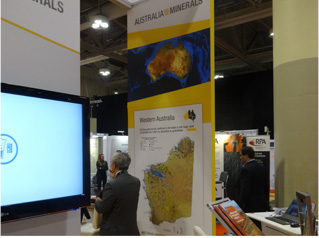 n establishing a stable and competitive investment climate was recognised in the latest international Fraser Institute Survey which saw Western Australia placed as the world's top-rated jurisdiction for investment attractiveness, and the top Australian state for the past three years in the Policy Potential Index category."
n establishing a stable and competitive investment climate was recognised in the latest international Fraser Institute Survey which saw Western Australia placed as the world's top-rated jurisdiction for investment attractiveness, and the top Australian state for the past three years in the Policy Potential Index category."
The Director General’s presentation entitled ‘Attracting risk capital using incentives: the Exploration Incentive Scheme (EIS) in Australia’, looked at many of the success stories that have resulted since 2009 from a State Government commitment of $130 million.
During that period the co-funded drilling component of the scheme resulted in 506 projects being offered co-funding, 214 projects drilled, 37 projects in progress and a further 74 projects that are due to commence drilling.
As well as co-funded drilling the EIS has also provided funding for geophysical and geochemical surveys, 3D prospectivity mapping, exploration facilitation and strategy research with industry.
“Drilling in under-explored areas is the key to new discoveries, which create new projects and much need employment opportunities,” Mr Sellers said.
He said 2015 was a landmark year for the scheme, with the $440 million Sirius Resources’ Nova nickel project now under construction – becoming the first new mine to result from EIS co-funded drilling.
“The co-funded drilling program has had a number of successes in the past year including gold at Alloy Resources’ Horse Well project, antimony mineralisation at the Artemis Resources Eastern Hills project, zinc at Millennium by Encounter Resources and nickel by Panoramic Resources at its Savannah North project,” Mr Sellers said.
“Since the EIS began, it has supported more than 350,000 metres of drilling across the State and directly or indirectly contributed to at least 20 new discoveries.”
Major achievements at DMP over the past year
As we progress into the new year, the DG’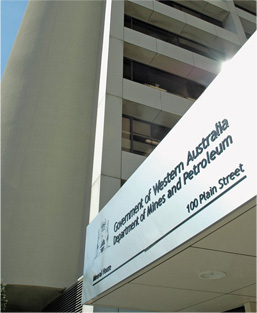 s eNews takes a look at some of the significant achievements the department has made during 2014.
s eNews takes a look at some of the significant achievements the department has made during 2014.
There was considerable progress towards a more consistent, transparent and risk-based regulatory framework for the resources sector, focused on providing robust regulation of safety and the environment, and greater investor certainty.
The Auditor General recognised significant improvements in DMP’s assessment, inspection and reporting processes with more transparency to enable better environmental compliance by the mining industry.
There was a continued focus on streamlining the approvals process through expansion of online lodgement facilities (the majority of applications are now lodged via the internet) and extending DMP’s approval tracking system to other agencies to allow proponents to track across government.
DMP’s public reporting of compliance with approval performance targets were also recognised by the Productivity Commission as leading practice in Australia.
The year also saw the successful implementation of the Mining Rehabilitation Fund (MRF), an innovative approach to addressing the State’s abandoned mines liabilities which was a finalist for the Premier’s Award in the 'Developing the Economy' category.
The department continued to expand its community engagement efforts to build confidence that the resources sector is well regulated, particularly with regard to issues such as the development of the State’s shale and tight gas resources and carbon capture and storage.
The highly successful Exploration Incentive Scheme (EIS) saw two rounds of the Co-funded Exploration Drilling program which resulted in offers of co-funding to 90 successful applicants.
This program continues to yield exciting results with several earlier co-funded projects progressing to feasibility stage and beyond, including Sirius Resources’ Nova nickel project, for which a mining lease was granted in 2014.
Following a decade’s work by the Geological Survey of Western Australia (GSWA), 2014 saw the release of a 1:500 000 interpreted bedrock geology map that will greatly assist explorers and geologists find the mines of tomorrow.
In April 2014 DMP released a report analysing mining fatalities in Western Australia between 2000 and 2012 which has identified key activities and areas where industry can make changes to improve safety outcomes.
In May Geoscience Australia announced the discovery of rocky outcrops on both North Scott Reef and Seringapatam Reef which resulted in a re-definition of the Australian Maritime Boundary (AMB) with areas excised from the Commonwealth Adjacent Area and included in Western Australia’s Territorial Seas.
The Woodside led Browse JV has both Commonwealth and State Retention Leases over this area, covering the Brecknock, Calliance and Torosa gas fields.
Legislation to effect the change and provide certainty of tenure for Browse Joint Ventures was approved by Parliament in November, significantly lifting the State’s potential share of the Browse Basin gas field.
It is estimated the boundary changes could mean increases in State royalty collections of up to $2.9 billion over the life of the Torosa field alone.
The 2013 Fraser Institute Survey of Mining Companies, released in March 2014, ranked Western Australia as the top-rated mining jurisdiction for investment attractiveness, mineral potential and regulatory certainty.
Legislation
- Mining Safety and Inspection Amendment Bill 2014 passed both Houses of Parliament on 25 November 2014 – Awaiting Assent
- Petroleum Titles (Browse Basin) Bill 2014 passed both Houses of Parliament on 25 November 2014 – Awaiting Assent
- Mining Amendment Regulations (No 4) 2014 Gazetted 28 November 2014 – These changes to the Regulations clarify the Royalty obligations for iron ore ensuring all iron ore royalties are calculated using the export value of iron ore.
Mine Openings / Launches during 2014
- Andy Well gold project near Meekatharra – Doray Minerals Ltd – announced it had intersected more high-grade gold mineralisation (30 January 2014)
- Tropicana Gold Mine – Anglogold (opened 6 March 2014)
- Jimblebar Iron Ore Mine (opened 23 April 2014)
- Atlas Iron’s Mt Webber Mine (opened 15 July 2014)
- Carina New Trains Launch (on 23 July 2014)
- Towards the end of 2014 Northern Star reported a new gold discovery near its Kanowna Belle mine.
- AWE and Origin Energy have discovered what could be the largest onshore gas discovery since the Dongara field in 1966.
- Apache also announced the discovery of a significant commercial oil field in State waters off Port Hedland.
December quarter approvals performance on target
The Department of Mines and Petroleum’s (DMP) December 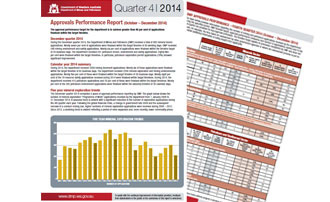 quarter 2014 approvals performance report continues to show strong performance across key approval processes.
quarter 2014 approvals performance report continues to show strong performance across key approval processes.
DMP Director General Richard Sellers said the majority of key approvals submitted to the department continue to be addressed within target timelines.
“During the December quarter the department received more mining proposals than any time since the final quarter of 2011, and this increase has been accompanied by a lift in applications for exploration and prospecting,” Mr Sellers said.
“There were 882 mineral tenure applications received during the December quarter and 3359 received during the 2014 calendar year,” he said.
Ninety six per cent of mineral tenure applications were finalised within the 65 business day target timeline in 2014.
In addition, 2294 mineral exploration and mining environment application were received in 2014 of which 95 per cent were finalised within the target timeline of 30 business days.
More than 94 per cent of the applications received by the department during the 2014 calendar year were finalised within target timelines, exceeding the department’s approval performance target of more than 80 per cent of applications finalised within target timelines.
Mr Sellers said the December quarter 2014 completed five years of approval performance reporting by the department, with clear trends becoming evident.
Programme of Work (PoW) applications, required for mineral exploration, peak in the middle quarters of each year.
“An increase in mineral exploration application occurred from 2009 to 2012. This followed the global financial crisis, a change in government and the subsequent removal of the uranium mining ban,” Mr Sellers said.
He said a declining trend can be seen since 2012, reflecting a period of mine expansion and recent lower commodity prices.
The full report can be viewed on the DMP website.
Round 11 co-funded drilling program closes soon
Applications close early next month 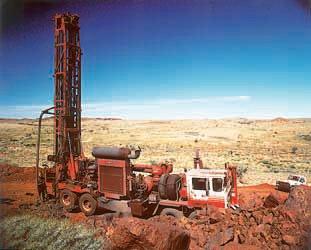 for Round 11 of the highly successful Exploration Incentive Scheme (EIS) co-funded drilling program.
for Round 11 of the highly successful Exploration Incentive Scheme (EIS) co-funded drilling program.
The State Government has made available a further $5 million to promote drilling in under-explored areas which is essential for new discoveries.
“This year also marks the commencement of construction of the first new mine to result from co-funded drilling, the $440 million Sirius Resources’ Nova nickel project,” DMP Director General Richard Sellers said.
“Over the past year the drilling program has continued to assist in making more discoveries including gold at Alloy Resources’ Horse Well project, antimony mineralisation at the Artemis Resources Eastern Hills project, zinc at Millennium by Encounter Resources and nickel by Panoramic Resources at its Savannah North project.”
Since the EIS began, it has supported more than 350,000 metres of drilling across the State and directly or indirectly contributed to at least 20 new discoveries.
“Additionally, the State Government has committed to annual funding of $10 million for the three years from July 2014 until June 2017, bringing the total of EIS funding to $130.4 million since it was launched in 2009,” Mr Sellers said.
More than $19.6 million has already been refunded through the co-funded drilling program to more than 250 projects.
The co-funded drilling program allows successful applicants to claim 50 per cent of incurred drilling costs.
Applications for the latest round of grants close on April 10, 2015 and for more information visit the Exploration Incentive Scheme page
New DMP website nears launch
The new Department of Mines and 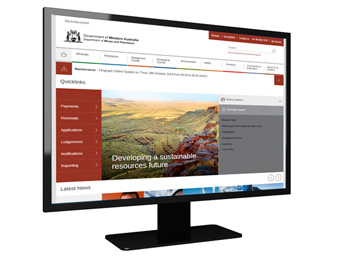 Petroleum (DMP) website is due to go live on 1 July 2015.
Petroleum (DMP) website is due to go live on 1 July 2015.
“The Website Redevelopment Project has involved three years of networking, research, testing and stakeholder engagement, as staff across DMP have worked together to create a brand new website, rather than a makeover of the existing site,” DMP Director General Richard Sellers said.
“Over the past six years technology has rapidly changed, as has the way people access information and interact online.”
He said the streamlining of approvals through the expansion of online applications has resulted in the majority now being lodged through the website.
“We have also extended the department’s approval tracking system to other agencies to allow proponents to track across government,” Mr Sellers said.
He said the new website had been built around the concept of providing what DMP website users want, making the website intuitive and easier to use.
“Secondary research was also undertaken to look at world-leading website design trends, including examining government and private industry sites from across Australia and overseas,” Mr Sellers said.
Besides providing easy-to-find information on Western Australia’s resources industry, the new website will also have new sections that promote investment in WA.
Mr Sellers said the department will also run briefing sessions for clients and stakeholders prior to the launch, with details to be announced on the department’s website.
Cutting out the paperwork with Digital DMP
The Department of Mines and Petroleum (DMP) has made 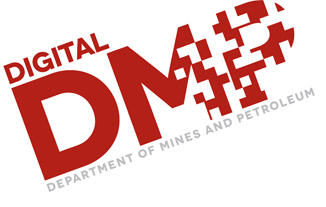 significant progress on its flagship project to improve processing timelines, cutting red tape and speeding things up for customers.
significant progress on its flagship project to improve processing timelines, cutting red tape and speeding things up for customers.
These improvements were the subject of extensive consultation and negotiation with stakeholders before their continuing implementation throughout the department as part of an internal improvement project – Digital DMP.
“We’ve made excellent progress on improving timelines and cutting red tape,” DMP Director General Richard Sellers said.
“Speeding up applications is a key improvement area and now almost 40 per cent of our customer transactions are being conducted digitally, with more than 30,000 customers already registered to use online DMP systems and services.
“Our target date to be almost completely online is mid-2016, but the exact date will be determined through continuing consultation with industry and other stakeholders on the areas that need improving.”
Mr Sellers said that he understood that DMP’s stretch target to make use of its online systems mandatory after 1 July 2016 was challenging, but pointed to achievements in the areas of the Mining Rehabilitation Fund (MRF) and Programme of Work applications.
“The successful introduction of the online use of these programs reinforces our commitment to focus on customer service and maintain good communications with our stakeholders,” he said.
“We’ve talked to industry and taken their concerns on board and we will keep talking to them.
“The primary aim of Digital DMP is to streamline approvals and increase efficiency in our processes, and industry has been working with us to cut duplication and the amount of documentation required.”
Mr Sellers said that a small number of transaction types had been identified as being unsuitable for online systems and would be exempt when an online system that industry was expected to use became available.
“For example, Miner’s Rights will be exempt because it is important for applicants to have face-to-face contact with a Mining Registrar,” he said.
“Meanwhile, a number of digital milestones have been recorded.”
Registration, submission, processing and correspondence relating to the MRF were all now being done online and industry uptake had been exceptional.
By 30 June 2014, more than 95 per cent of almost 23,000 eligible tenements had registered for the MRF and submitted data online.
Mr Sellers said that despite some initial concerns that prospectors might struggle with an online system, they achieved the highest submission rates with more than 99 per cent of prospectors lodging their MRF data online by the end of June 2014.
In the Resources Safety Division, 100 per cent of Project Management Plans were being lodged online, as were 70 per cent of Mining Proposals and 87 per cent Environment Plans in the Environment Division.
“We’re making impressive, steady progress and we will keep consulting with industry and the community to make sure these kinds of achievements happen without causing inconvenience,” Mr Sellers said.
“The reality is that this is the space the next generations are working in and we need to ensure our systems will be compatible with changing international standards and the needs and expectations of the younger workforce coming through.”
DMP hailed as one of world’s best regulators
Minerals and energy law expert Dr Tina Hunter 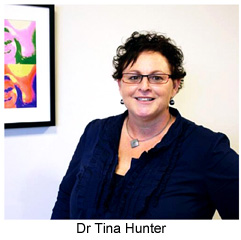 has identified the Department of Mines and Petroleum (DMP) as one of the three best regulatory organisations in the world.
has identified the Department of Mines and Petroleum (DMP) as one of the three best regulatory organisations in the world.
Dr Hunter made the comments when asked if she believed DMP had taken seriously her recommendations made in a review she was commissioned to undertake in 2011 relating to shale and tight gas activities in Western Australia.
She said WA’s DMP was one of only three regulators worldwide – the other two being South Australia and DECC (the Department of Energy and Climate Change) in the UK – that she recognised as a comprehensive and competent regulator.
“In my view they are professional and have the necessary experience and processes to implement best practice in the regulation of unconventional natural gas,” she said.
Dr Hunter dismissed the suggestion that DMP could have a conflict of interest in enforcing regulations for an industry it “subsidised”.
“DMP does not subsidise the industry,” she said.
“The State Government has several roles as owner of the resources, regulator, granter of access to the resource and the body that collects revenue.
“This inherently creates conflict for any government agency, not DMP in particular.”
Asked if she believed new resource management regulations being introduced by DMP were adequate, Dr Hunter said she had been heavily involved in the drafting and that they represented good practice.
“As you would have seen in my report, the DMP is a fine regulator that needs laws to support it,” she said.
“The laws that have been drafted and are being implemented will give the regulator the necessary tools to effectively regulate petroleum activities in WA.”
Dr Hunter said that she believed it was essential that the State Government should be the regulator of the industry.
“But it is also essential that the regulator builds competency and is as competent as the companies it is regulating,” she said
“DMP is exceptionally competent.”
Dr Hunter is the inaugural Director of the Centre for International Minerals and Energy Law and teaches at the University of Queensland
An Honorary Research Fellow at the University of Aberdeen, Scotland, Dr Hunter has consulted to governments, industry groups and NGO's in several jurisdictions including Australia, New Zealand, the UK, Russia and Canada.
Saving lives the focus of Karratha forums
Saving lives by making risks ‘As Low As Reasonably Practicable’.jpg) - or ALARP - was the focus of two Karratha forums for petroleum and major hazard facility operators held last month.
- or ALARP - was the focus of two Karratha forums for petroleum and major hazard facility operators held last month.
Incidents such as the Varanus Island pipeline explosion, the Montara blowout and the Deepwater Horizon disaster highlighted the critical risks presented by petroleum operations and major hazard facilities.
It has been more than 25 years since the Piper Alpha oil production explosion where 167 men died in the North Sea and forever changed safety in the industry.
The forums will promote the concept of ALARP and highlight how petroleum industry workers and major hazard facility operators can reduce their risks.
They will also detail requirements of the Department of Mines and Petroleum (DMP) for documenting safety cases and reports.
The Karratha events follow the State’s first ALARP forum in Perth last November, hosted by the department’s new Critical Risk Group.
Bookings for the Perth event were high. Following discussions with local operators, the department decided to host forums in the Pilbara, which has a high concentration of petroleum and major hazard facilities.
Attendees at the Perth event provided feedback that it was extremely informative and helped operators improve internal processes, while reducing review times for safety case reports submitted to the department.
DMP Director General Richard Sellers said forums like these were an important part of the department’s work with the petroleum sector to improve safety outcomes in Western Australia’s resources industry.
Facts outlined on environmental assessment fees
As part of a reform program the Department of Mines .jpg) and Petroleum (DMP) has been implementing for a number of years, assessment fees will be introduced for Programme of Work and Mining Proposal applications from 1 July 2015.
and Petroleum (DMP) has been implementing for a number of years, assessment fees will be introduced for Programme of Work and Mining Proposal applications from 1 July 2015.
Exemptions will apply to exploration and prospecting work deemed “low impact”.
DMP Executive Director Environment Dr Phil Gorey said operations will be deemed “low impact” if they disturb less than a quarter of a hectare and are not on reserve land.
The assessment fees are a government decision to ensure the department is appropriately funded to deliver the functions and expectations of government and the community.
“Industry-based fees have been decided by government as the appropriate funding mechanism for the environmental reform agenda,” Dr Gorey said.
“Effective environmental regulation of the mining industry means that unacceptable impacts upon the environment are minimised, community confidence in the regulation of the industry is maintained, and the industry retains its social licence to operate,” Dr Gorey said.
“A number of reforms have already been introduced that cut red tape and reduce the regulatory burden on industry and DMP is continuing to explore further ways to reduce regulatory burden.
“Current environmental reforms being delivered by DMP are calculated to save industry $32 million each year; however the efforts of the department in regulating the mining industry do come at a cost.”
The value of assessment fees proposed to take effect from 1 July 2015 are $6950 for mining proposals and $590 for programmes of work.
“These fees are being introduced following wide consultation with industry stakeholders,” Dr Gorey said.
“To ensure continued high levels of environmental regulation it is important the regulator maintains appropriate levels of funding.”
DMP has published a fact sheet on the assessment fees outlining the reasons they’re being introduced, the consultation undertaken, and how they will be applied.
The fact sheet can be accessed from the DMP website.
New Geological Survey of WA eBookshop offers almost 5,000 products free of charge
The Department of Mines and Petroleum (DMP) 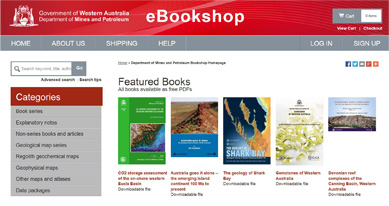 now offers a transformed and revamped eBookshop providing electronic access to the full suite of products available from the Geological Survey of Western Australia (GSWA).
now offers a transformed and revamped eBookshop providing electronic access to the full suite of products available from the Geological Survey of Western Australia (GSWA).
Replacing the previous online version, the updated application is a completely new system where users can now securely purchase a range of products electronically using their credit card.
The GSWA eBookshop offers almost 5,000 products including books, reports, maps and digital products, virtually all of which can be downloaded free of charge.
Maps, USB data packages and nine premium publications are available for purchase as hard copies. A new online cart and payment system is in place.
Geological Survey maps, records, reports, bulletins and non-series books cannot be purchased in hard copy, but are all available as PDFs to view and download.
The site also highlights featured books, including the popular Geology of Shark Bay and Gemstones of Western Australia, which are available as free downloadable PDF files.
Other featured free PDF titles include CO2 Storage Assessment of the on-shore western Eucla Basin, Australia goes it alone – the emerging island continent 100 Ma to present, and Devonian Reef Complexes of the Canning Basin, Western Australia.
Users can also purchase data packages including Kimberley 2014, Exploration geochemistry of Western Australia 2014, and the Western Australia carbon dioxide geological storage atlas.
“The new eBookshop interface is colourful, shows thumbnails of all products for easy navigation, and the landing page can be updated with new products for display,” said Mines and Petroleum Minister Bill Marmion at the official launch held earlier today.
“The main role of GSWA is to provide world-class pre-competitive geoscience information. The new eBooshop will make that information even more accessible to help find the mines of tomorrow,” he said.
DMP has full access to the administration console for uploading products as they become available.
The revampled eBookshop can be accessed using the original bookshop.
New app puts mineral search at your fingertips
Western Australia’s cutting-edge 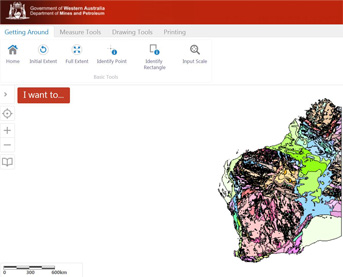 mapping and geological information is now available on mobile phones and tablets.
mapping and geological information is now available on mobile phones and tablets.
The WAGeology app puts detailed digital geological maps at your fingertips including multiple layers of information such as land use, native title and biodiversity,” Department of Mines and Petroleum Director General Richard Sellers said.
“The app includes measuring, drawing and mapping tools, with the advantage of GPS accuracy, which will be of great benefit for prospectors and explorers.”
The WAGeology app was developed from DMP’s extensive and growing digital database and the department is working on building a caching facility so that information is available on smartphones and tablets even when out of mobile signal range.
The WAGeology app is available at http://wageology.dmp.wa.gov.au/wageology
New State-wide digital map to assist explorers
A new seamless, State-wide Interpreted 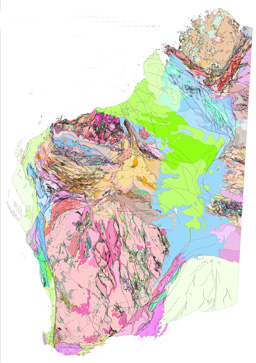 Bedrock Geology digital map is set to provide a more accurate backdrop for resources exploration.
Bedrock Geology digital map is set to provide a more accurate backdrop for resources exploration.
Developed by the Department of Mines and Petroleum’s (DMP) Geological Survey of Western Australia (GSWA), the 1:500 000 scale map will form the base layer for future GSWA maps and spatial products.
These new special maps will give explorers a consistent summary of the geology of Western Australia and will also become the base layer for many of DMP’s spatial databases.
The up-to-date geological framework will provide a more accurate backdrop for exploration that will allow geologists to show the geological framework, or building blocks, of the State.
GSWA Executive Director Dr Rick Rogerson said as well as being more accurate spatially, more information about each map unit than ever before is included.
“This will provide a wealth of additional information which will be of great assistance to explorers and geologists,” he said.
The 1:500 000 interpreted bedrock geology map is a complete reinterpretation and update based on GSWA mapping since 2000, and is the culmination of a decade’s work and a new understanding of the geology of Western Australia.
“It is a set of intelligent spatial layers, rather than a single map and includes interpreted bedrock faults and folds and areas of significant Cenozoic deposits, a separate layer of rocks less than 65 million years old,” Dr Rogerson said.
“The layers aim to illustrate the regional geological framework of Western Australia in as much detail as possible at this scale, rather than being simply a standalone map.”
The lookup table for the main interpreted bedrock geology layer is sorted using tectonic subdivisions first and then age, providing the digital equivalent of a map legend.
“As well, the recent geophysical datasets acquired as part of the State Government’s Exploration Incentive Scheme (EIS) have been used extensively in generating the map,” Dr Rogerson said.
Updates were already planned and will be released incrementally as more information becomes available.
One of the State Government’s highest priorities is to encourage exploration and promote opportunities for high risk minerals and energy investment in Western Australia.
“Using the latest in innovative technology will assist this aim and provide explorers and geologists with updated geophysical data to help them find the mines of tomorrow,” Dr Rogerson said.
He said spatial layers at 1:2 500 000 scale, including geological polygons, structures and tectonic divisions, were the next target resulting in a new, revised State Geological Map — the first since 1998, and the first compiled entirely digitally.
The 1:500 000 scale layers and associated lookup tables are available as a download from the department’s Data and Software Centre
Former petroleum head receives Gas Industry Development Award
Department of Mines and Petroleum (DMP) 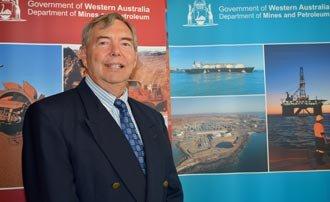 former Executive Director Petroleum Bill Tinapple has again been recognised for his contributions to the Western Australian oil and gas industry.
former Executive Director Petroleum Bill Tinapple has again been recognised for his contributions to the Western Australian oil and gas industry.
In December Mr Tinapple was awarded the prestigious Western Australia Gas Industry Development Award, which follows the John Doran Lifetime Achievement Award he received in September.
The Gas Industry Development Award recognises outstanding contribution by an individual or company toward development of the domestic gas industry in Western Australia.
DMP Director General Richard Sellers said Mr Tinapple’s contributions to oil and gas development in the State had been substantial.
“Bill was heavily involved in the development of the North West Shelf, from the initial engineering studies and 3D offshore surveying in the 1990s through to the development of floating liquefied natural gas production, storage and offloading units,” Mr Sellers said.
“During his time leading the department’s Petroleum Division he improved customer service, increased investment in Western Australia, and sustained production, seeing Western Australia develop into one of the world’s premier LNG production regions.”
Mr Tinapple spent over 15 years with DMP, moving to Western Australia in 1998 following his 12 years as a regulator in the Northern Territory.
Originally from Ohio, Mr Tinapple worked on oil and gas projects in the US, Libya, Indonesia, the North Sea, Norway, Nigeria, Japan, Australia and Abu Dhabi prior to settling in Australia in 1985.
DMP welcomes findings of Auditor General report
A report released towards the end of last year by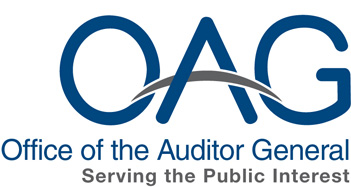 the Auditor General has praised environmental reforms implemented by the Department of Mines and Petroleum (DMP) over the past three years.
the Auditor General has praised environmental reforms implemented by the Department of Mines and Petroleum (DMP) over the past three years.
The report follows a performance audit undertaken by the Office of the Auditor General to assess whether issues identified in a 2011 audit and report on the effectiveness of the monitoring of compliance with conditions placed on mining activities had been addressed.
“The report states that DMP has made significant improvements in addressing the issues identified in 2011, and that the full benefits of the reform will be seen over time,” DMP Director General Richard Sellers said.
He said following the 2011 audit, the Auditor General recommended DMP and other agencies responsible for environmental regulation of mining activities made a number of changes to better ensure compliance with conditions on mining.
“Since the 2011 report, the department has implemented several reforms to improve its compliance risk based methodology and records management, and has implemented significant changes to its operational assessment and compliance processes to improve oversight of mining activities,” Mr Sellers said.
“My department has also implemented new information technology systems and practices to monitor compliance and the environmental performance of industry operators, and significantly expanded the public availability of this information.”
He said the Reforming Environmental Regulation program had continued to be implemented, along with the establishment of the Mining Rehabilitation Fund (MRF) to address financial issues arising from legacy and abandoned mines.”
The report also recommended that DMP finalise policies and procedures for assessing abandoned mines by June 2015.
Stakeholder consultation is underway and the final stage of significant legislative reforms to the Mining Act arising from the reforms is planned to be presented to government for consideration in early 2015.
In 2015 DMP is scheduled to implement the outstanding tasks from the Reforming Environmental Regulation initiative and achieve its commitment of implementing the principles of best practice environmental regulation within the department.
The full report is available on the Office of the Auditor General website.